|
Hednesford Town Centre
|
|
The origins of Hednesford
The first recorded mention of Hednesford was in 1153, when King
Stephen II granted the small settlement of Hedenedford exemption
from pannage dues. Pannage was a tax that was imposed for the
right to feed animals such as swine in the nearby wood or forest.
By the late 12th century, a family of knights named
Trumwyne owned some land here. Records suggest that
other families arrived during the same period, but as late
as the early 16th century, the settlement was probably
only inhabited by around fifty people.
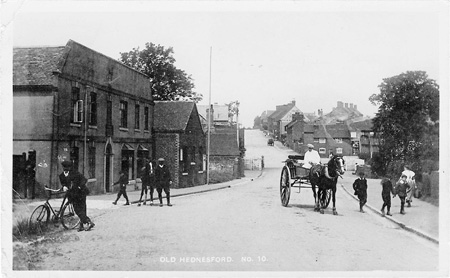
This postcard shows Old Hednesford c1920.
In the foreground on the left is the Cross Keys Inn. On the right, near
the top of the hill, is the Queen’s Arms public house. Built in 1866, it
still remains today. Where the road dips you can see the crossing of
the Cannock Mineral Railway line, which opened in 1859.
Image courtesy of Ray Smith
 |
Could these letters on the exterior of the
Cross Keys Inn give us a clue about its
past as a coaching inn? It is possible that
they stand for Taylor’s Wagon Company,
which was a large company in the
Midlands at the time. An alternative
theory is that the letters are the initials
of a previous landlord. |
The Cross Keys Inn
The centre of Hednesford was once based about three
quarters of a mile from here,
in the area where the
Cross Keys Inn now stands.
The Cross Keys Inn was built in 1746,
and is among the
oldest buildings in the town. The busy road on which it
stood
was originally an ancient packhorse route
called
Blake Street. In the eighteenth century the inn was a
staging post for
stage coaches and road wagons.
Splash Lane, opposite the Cross Keys Inn,
c1920. Near to this area, originally called
le Plash, there was once a stream. In Saxon
times, it is thought that a man named
Heddin or Hedda built a ford over the
stream, and it is possible that the area
became known to travellers as Heddin’s
Ford, which eventually became Hednesford.
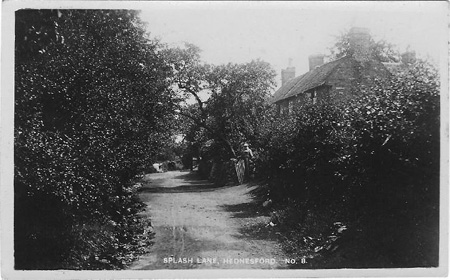
Image courtesy of Ray Smith
Early industry
The 15th century saw the beginnings of early industry in the
area. In 1473 there was an iron forge in Hednesford, and by
about 1561 William Paget had built the first blast furnace in
the Midlands, along what is now the Hednesford to Rugeley
road.
|

Although Hednesford was once dominated by the coal industry, a few other industries have played a role in the town’s history. Hednesford Brickworks, which was near the current ground of Hednesford Town Football Club, was one of the largest in the area. Before nationalisation of the coal industry in 1947, it was owned by Cannock Chase Colliery Company.
Image courtesy of the Museum of Cannock Chase

When this postcard was sent, in 1911, Hednesford was enjoying a period of prosperity.
Image courtesy of Ray Smith
From village to thriving town
Although still primarily an agricultural area,
during the first half of the 19th century
some small coal mines had been sunk
nearby and a number of other trades had
emerged in the village. The population
had originally settled in the area around
the Cross Keys Inn, but began to spread
further afield.
In the late 1850s, the operations of the
Hednesford Colliery Company attracted a
significant number of newcomers to the
area. The rapid growth in the local coal
industry was boosted by improved
transport links. By 1881, the population
had rocketed to almost 7,000 people, and
over 50% of the male villagers were
employed in coal mining.
During the late 19th century and early
20th century, the prosperity of the area
continued to grow. The town centre was
thriving, and Hednesford market was the
principal market in Cannock Chase.
Coal mining in decline
After the Great War the local coal industry fell into
depression, forcing the closure of some of Hednesford’s
collieries. More closures followed nationalisation in 1947.
In the 1940s and 1950s Hednesford saw further changes
in the wake of redevelopment when many areas of
terraced housing were demolished.
In 2006 a memorial to local miners was erected outside
the town’s library. Miners’ relatives were able to buy a
brick, which was then engraved with the name of the
person they wished to commemorate, along with the
name of the colliery at which they worked.
Horse training in Hednesford
The hills around Hednesford have excellent drainage and good turf,
and are ideal for training race horses. By the early 19th century,
horse training here was gaining national importance. In 1841,
eighty-seven locals were employed in the training of horses.
Hednesford today – and tomorrow
In recent years, attention has turned to town centre regeneration –
and so the face of Hednesford continues to change.
|
Explore and discover
Patterns in brickwork |
|
Brick walls are built to a repeating
pattern known as a bond. The two
most common are English bond and
Flemish bond, which you can spot
throughout Hednesford.
Headers and stretchers
When the long side of the brick is visible in
the wall it is called a stretcher, and when the
end of the brick is visible it is called a header.
English bond is stronger than Flemish bond
since it has more header bricks connecting
the two courses. A garden wall bond has
fewer headers still, and is best for walls that
do not need to bear much weight.

|
Headers and stretchers
When the long side of the brick is visible in
the wall it is called a stretcher, and when the
end of the brick is visible it is called a header.
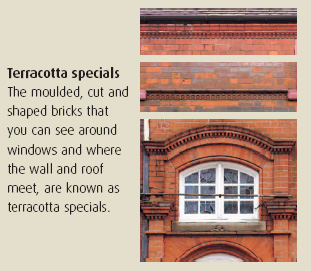
 When locally-made
bricks were fired in kilns,
the parts nearer to the
heat source were often
darker in colour. Builders
used this variation in
colour to create brickwork patterns and designs.
In this wall, it looks as if the stretcher bricks are
baked more thoroughly than the headers. When locally-made
bricks were fired in kilns,
the parts nearer to the
heat source were often
darker in colour. Builders
used this variation in
colour to create brickwork patterns and designs.
In this wall, it looks as if the stretcher bricks are
baked more thoroughly than the headers.
|
| |
|
In and around Market Street
|
|
Down memory lane:
shops in Hednesford centre Many Hednesford residents have fond memories of the shops and businesses that were in their town, which were often longestablished, family-run firms that formed a very important part of the local community.
Blagg’s ironmonger’s
At the southern end of Market Street, at the corner of Church Hill on the Rugeley Road, was Blagg’s ironmonger’s. Among the wide range of items they sold were leather goods, which were manufactured on the premises. The business came to Hednesford from Leek in 1865. In later years they had a shop in Rugeley, as well as a depot in Brereton. Blagg’s traded in Hednesford until 2003. The building was demolished in 2007.
Information provided courtesy of Anthony Hunt

Image courtesy of the Museum of Cannock Chase
What can you see for sale in this photograph of Blagg’s?
Look out for a folding chair, fireplaces, hurricane lamps, mangles, sieves, washing tubs, broomheads, dustpans, a wardrobe, buckets, garden forks, a washstand, and stepladders.
Tranter’s butcher’s
Tranter’s butcher’s stood on Market Street until the shop closed in 2000.
In about 1905 the firm moved here from the neighbouring village of Wimblebury, where it had been since before 1880. The Tranters reared their own pigs at the back of the shop and later built a bakehouse. They often produced over 300 pork pies a week, as well as pressed meats, faggots and sausages.
Information provided courtesy of Anthony Hunt

Market Street c1935. Near the centre of the image, adjacent to the clock, is a sign for the town’s Market Hall (now demolished). In the foreground on the left is a shop called ‘F Ayriss’, which is listed in the 1912 edition of
Kelly’s Directory of Staffordshire as a bootmaker.
Image courtesy of Ray Smith
Tribali’s café
Tribali’s café was owned by an Italian family, and its home-made ice cream was
a particular favourite. A local lady remembers it well:
We went there to buy ice-cream after church functions at the Lady of Lourdes
church or after tennis in the park. They sold various flavours – I seem to
remember tutti-frutti, Neopolitan and mint and chocolate chip, but my
favourite was rum ’n’ raisin, which for me was the height of decadence!
|

Market Street in the early 1900s. Frisby’s shop, which you can see on the
right, was a well-known boot and shoe dealer that was established in
Hednesford some time before 1912.
Image courtesy of Ray Smith
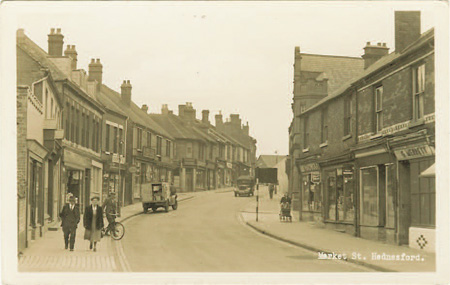
Image courtesy of Ray Smith
Market Street in the 1950s. Note the two-way traffic system, which didn’t become a one-way system until the early 1990s. One local resident clearly remembers Andrew’s shop, which you might be able to spot on the left of the image:
Andrew’s sold sweets, newspapers, fancy goods, postcards and best of all – fireworks. In the 1950s fireworks were sold ‘loose’ and were on display in a glass fronted cabinet. Many hours were spent admiring the ‘rockets’, ‘jumping jacks’ and ‘Roman candles’! Your purchases (to young children) were put in a brown paper bag and the bag had a lovely smell of gunpowder.

|
Explore and discover
Our Lady of Lourdes |
|
Just off the Cannock Chase Heritage Trail, on Uxbridge Street, is the striking Roman Catholic church of Our Lady of Lourdes, which was officially opened in 1934.

A postcard of Our Lady of Lourdes c1935. The life-size statue of Our
Lady, near the top of the building, is carved from Portland Stone.
Image courtesy of the Museum of Cannock Chase
The church was inspired by the shrine at Lourdes, in France, which is a site of pilgrimage for Catholics from all over the world. In 1858, in a cave (or grotto) near Lourdes, a peasant girl, Bernadette Soubirous, had a vision of the Virgin Mary.
Hednesford’s first Catholic priest, Dr Patrick Boyle, made many visits to Lourdes, and decided to build a church in his own parish in honour of Our Lady.
Designed to resemble the church in Lourdes, the style of the building is 13th-century French gothic. It was constructed entirely of concrete, which was less expensive than brick or natural stone, then faced with white granite. To counteract possible subsidence, the concrete raft of the church was designed to be adjustable. At the time, this architectural feature was unique to the British Isles, and attracted a great deal of interest.
|
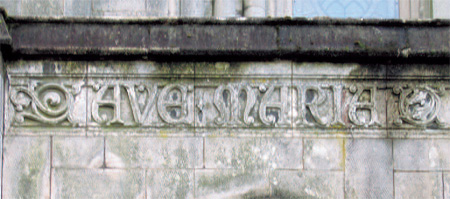
These Latin words, carved on the front of the church, are
from the beginning of the famous Hail Mary prayer
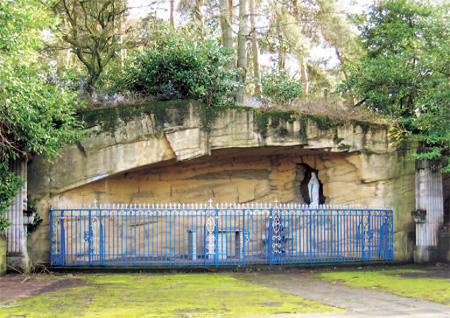
This grotto is a reproduction of the grotto at Lourdes. Today Our
Lady of Lourdes church receives many visitors from all over the
world, including those who join the three annual pilgrimages
that are made each year to the shrine within the grotto.
|
Cannock Chase Heritage Trail Kiosk Disclaimer
|








 When locally-made
bricks were fired in kilns,
the parts nearer to the
heat source were often
darker in colour. Builders
used this variation in
colour to create brickwork patterns and designs.
In this wall, it looks as if the stretcher bricks are
baked more thoroughly than the headers.
When locally-made
bricks were fired in kilns,
the parts nearer to the
heat source were often
darker in colour. Builders
used this variation in
colour to create brickwork patterns and designs.
In this wall, it looks as if the stretcher bricks are
baked more thoroughly than the headers.






